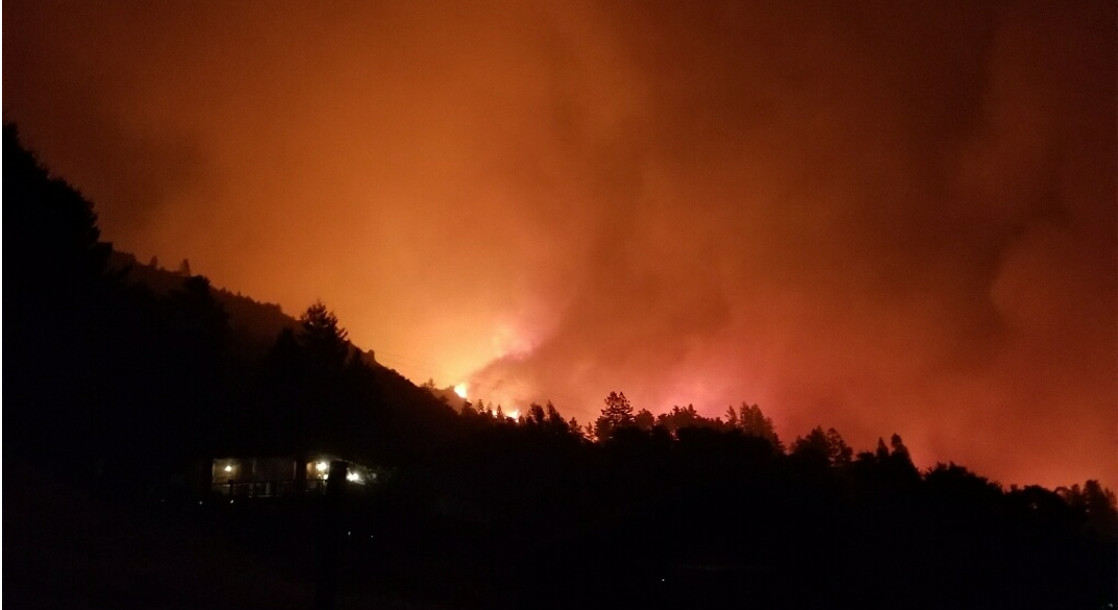Lead image by cannabis cultivator Subcool
Cannabis cultivators in Northern California have a unique and precious relationship to the land. Isolated among their plants and the redwoods, only local institutions like volunteer fire departments and school districts have historically drawn growers out of the hills and into town, where they’d congregate and exchange information on cultivation and genetics. They’d develop hybrids that eventually became popular strains — think Super Silver Haze or Purple Dragon — and were essentially native to the region. It was all spontaneous, says cannabis farmer Justin Calvino: growers would run into each other at a gardening shop like Friedman’s in Santa Rosa, or keep seeing each other around PTA meetings, and ask each other questions or catch up on life — but for them, growing weed is life.
The triad of Mendocino, Humboldt, and Trinity counties, which today we call the Emerald Triangle, is rooted in the “back to the land” movement of the ‘60s and ‘70s, when thousands of disillusioned youth and activists moved up north from the Bay Area and beyond to pursue a sustainable lifestyle in the country. Growing good weed was initially only a side hustle to sustain off-the-grid living; little did anyone realize they had the perfect recipe to transform cannabis cultivation and the nascent industry-at-large.
The seclusion that cannabis cultivators in Northern California have come to seek out and cherish — throughout the Emerald Triangle as well as in Sonoma and Santa Cruz counties — has been both a blessing and a curse. It’s given them the room and freedom to develop world-renowned marijuana, while simultaneously endangering their livelihood amidst the modern day “Green Rush” of legal cannabis entrepreneurs, as well as climate-driven disasters like the October wildfires. Meanwhile, their carefully-refined cannabis genetics, many of which are now considered heirloom strains, are also at risk.
Scorched bud, courtesy Subcool
Forget the Fires — If Your Bud’s Not Branded, You’re Out of the Game
New trends in the marketplace have impacted the artistry of cannabis cultivation, while the fires have underscored just how precious these genetics are to begin with.
“The fires brought to light the fact that Northern Californians are in a fragile economic situation in the market,” says cannabis cultivator Justin Calvino, co-founder of the Emerald Exchange and creator of the Mendocino Appellations Project. “We’re one fire or one car accident away from losing everything, but that has more to do with the firestorm of capitalism than natural disaster.”
Boutique mom-and-pop cultivators don’t need venture capitalists, funds, or foundations to save them, says Calvino. “We just need people to buy our cannabis. It’s telling a story about the resilient nature of Northern California farmers.”
Calvino’s Mendocino Appellations Project is increasingly important to the business interests of his cannabis-growing neighbors. The project contends that like fine wine, premium outdoor-grown cannabis also deserves distinction in the marketplace — via appellations, or official titles which communicate a crop’s origin story and natural environment. Calvino’s inspiration derives from the French wine industry, in which the term Appellation d’Origine Contrôlée refers to meticulously controlled regions of wine production vintners can appeal to for official designation. Think of it as a legally protected brand: true champagne only comes from the Champagne region of France; everything else is just sparkling wine.
As applied to cannabis, a strain’s appellation — which would be legally defined and labeled according to geography under Calvino’s plan — tells a story about its region, climate, and the environmental factors that determine how a farmer cultivates it (also known as terroir) and how a plant will ultimately express its genetics (also known as phenotype). A type of intellectual property, the appellations are established by collecting regional data to inform a set of legal standards to which farmers can appeal if they want to petition for an appellation. The passage of Senate Bill 94 this fall, which combined regulations for California’s medical and adult-use marijuana programs, now mandates a cannabis appellation of origin system that will create legal standards for products and establish true intellectual property through appellation petitions, due to be fully operational by 2021, says Genine Coleman, executive director for the Mendocino Appellations Project.
The Mendocino project currently distinguishes 11 regional zones, specifying not only regional and topographic terroir, but also cultural terroir like the socio-economic and political conditions that inform the lifestyle and agricultural practices native to northern California. The project would validate a cannabis product’s agricultural heritage — not just that it is the strain the farmer says it is, but that it’s bred according to regional practices and conditions. Historically, since cannabis has been bred under prohibition, the “traditional” approach varies among cultivators and counties. And because the appellations don’t just define quality, but also help cultivators prove the quality of their product, it’s a valuable marketing tool for those facing the threat of Big Corporate Cannabis.

Proposed cannabis appellations, courtesy Mendocino Appellations Project
But original northern California heirloom strains like Mendo Purp or Gorilla Glue Candyland, Calvino mentions, may still be en route to extinction; or even Blue Dream or Barry White. “The phenotype, essentially the expression of the terroir…is what is immediately at risk of extinction, as well as the genotype if the varietals are lost entirely,” explains Coleman. “The phenotype is particularly at risk as legacy farmers lose their craft due to market loss, regulatory barriers, et cetera, and it will happen very quickly because cannabis is an annual.”
Sure, the genetics can be cloned and cultivated anywhere, but it’s like this: You are your genetics (a.k.a. your genotype) — the product of your mother and father — and you could have been born and raised anywhere, but the OG You is from your hometown, and where you’re from and how you were raised affects how your genetics express themselves (i.e. your phenotype). When cannabis farmers talk about genetics, they’re not only talking about staple strains that they continually replicate for sale, but also those unique plants that they keep to experiment with if they’re seeking particular characteristics.
So a Blue Dream grown outdoors in northern California might be different from one grown indoors in, say, Colorado, since different environment and cultivation practices will change how the plant turns out. A good example of this was the Grow Off, a competition in which growers were given clones of the same plant, and nonetheless, came out with vastly different phenotypes depending on their cultivation techniques.
The parents of hybrids are often sitting in shacks that might not offer sufficient protection, says Calvino. The actual strain or the genetics may not be technically at risk, but the original phenotype is. “That’s what geneticists are doing: they’re strain hunting, and once they identify that unique phenotype-genotype expression, they catalogue it. That becomes the marker standard for the varietal, and then you can petition for use of that varietal for branding,” he explains.
The appellations hold in esteem the environmental and cultivation practices that historically have been paired with certain genetics, so the project merely aims to standardize the combination as a marker of quality. Genetics cultivated outside the scope of these standards may still offer similar effects on the user, but the phenotype will be different. Here’s another example: pizza was originally developed in Italy, in accordance with growing the tomatoes a certain way, in a certain environment, using certain ingredients, and putting it altogether in a particular way. You can still make pizza anywhere else in the world, but the farther you get from the original source, the more it will deviate from how it was authentically created.
Smart Farmers Lost Nothing in the Fires, But the Market is a Different Story
Subcool’s cannabis grow, before the fires
Smarter breeders and cultivators will keep their genetics in a seed bank. That’s what Subcool of TGA Genetics did, which is now the reason he says not everything is lost. A pioneer breeder and member of the High Times Seed Bank Hall of Fame, Subcool’s cannabis garden was in full harvest when he and his wife ran from their home, moments later engulfed by 300-foot flames. “We had ten minutes to get out,” Subcool recalls. “My house burnt down completely. We lost every seed, every photo, everything. It will take about ten years to get everything back on the menu, but there’s no mother that can’t be found.”
Subcool’s cannabis grow after the fires
Subcool had a million dollars worth of orders the day after the fire; he runs one of the largest seed companies in the world. “Some strains will take time to recreate,” he says. A mother plant must first go into a quarantine room for four months to ensure she’s pest and virus-free. Then the six-month breeding cycle can begin, in order to make seeds. With seed stalk preserved in a safe place, Subcool can pick out mother and father plants to recreate everything that was “lost” — but it will be a slow (and expensive) process.
Of course, breeding and cultivation must also adhere to market trends and the flow of cannabis economics. Those trends influence what consumers and dispensaries want to buy — and what cultivators end up growing in order to support themselves. “What’s going on right now is the Walmartization of weed,” says Subcool. “If the general public wants to go to Walmart and buy shitty prerolls, that’s what’s going to happen, but there will also always be a connoisseur market, just like the craft beer market.”
Even so, whether or not a cultivator grows boutique artisan bud, they need a strong label. “If you’re not branded by next year, you’re out of business,” Subcool says. “You can go buy Cheese or you can buy Subcool’s Cheese. It’s where marketing is moving.”
That’s where the appellations come in. That’s where Instagram comes in. If a cultivator doesn’t have a strong brand and a social media presence (not to mention state and local licensing), they’ll have no chance competing in California come 2018 when the legal market goes live.
Remains of Subcool’s home
Genetic Preservation Efforts are Scarce — And That’s a Problem
So even if some heirloom genetics are retrievable, a confluence of factors are pushing them out of the market. “If you’re limited to growing only a certain number of plants, then you can’t have an experimental garden to just keep genetics alive — you can only have space for whatever you’re committed to being taxed on,” says Los Angeles/Santa Cruz-based cannabis attorney Sasha Brodsky. “Between being limited to your taxed, regulated canopy, and what the market demands, you are not likely, nor incentivized, to grow that heirloom strain that no one knows about, or that most have forgotten about.” Regulation is fine to keep out harmful pesticides, but over-regulation makes it hard for small-batch artisan cultivators to experiment and survive. “It’s tax-apalooza at the local level, and small, handcraft, organic artisans and keepers of rare and amazing strains are being pushed out of the game,” he says. “The current industry and legal structure makes it easiest for the big players who seem most interested in the bottom line and have little incentive to promote genetic diversity.”
Cultivators agree it’s crucial to protect and encourage preservation projects. Preservationists have strains that take over 100 days to flower, but Green Rush marketeers are looking for strains that germinate quickly, in less than, say, 50 days. “They’re not willing to explore anything outside the bottom line, so if it’s not a gas or a purple, they don’t want it because that’s not what the money wants,” says Brett Dosperos, founder of CaliDepFest, a Santa Cruz educational festival on sustainable cannabis. “The slower strains, usually sativas, are mixed into these faster strains to help them have diverse flavor profiles and add key ingredients like CBD, THCV, or specific terpenes. But the preservation of long-flowering strains [is getting] lost in the Green Rush.”
Burned out cannabis grow, courtesy anonymous farmer
These less-popular strains are vital to the genetics we currently have — they may not be moneymakers in and of themselves, but their preservation is necessary to ensuring that cannabis genetics remain nuanced and diverse. That’s important especially for the medical market, as whole-plant advocates continue to grow exceptional strains to target specific ailments. For example, one patient claims that only “Corazon,” Yerba Buena‘s version of AC/DC, is effective in treating his shoulder arthritis. “Because of the entourage effect [the symbiotic relationship among all the chemicals in cannabis], we need as many strains as possible. There’s a major, extremely urgent concern to collect, share, and work with all these genetics before they get polluted,” says Dosperos. “Strain hunters are going across the globe, collecting the world’s rarest landraces [indigenous cannabis plants], enhancing those genetics and polluting those landraces in areas that are hard to get to. Unfortunately that wipes out those pure genetics.”
For instance, The Phylos Galaxy, a public database of cannabis genetics created by testing lab Phylos Bioscience, has around ten different samples of Blueberry, a variety originally developed by legendary breeder DJ Short in the ‘70s. “They can’t all be Blueberry because they’re not genetically identical or even related to each other. So it’s difficult to know [which] is the Blueberry that DJ Short developed,” says Alisha Holloway, Vice President of Data Science at Phylos.
There are few significant efforts to preserve historical cannabis germplasm, or living genetic resources including seeds. There are only disparate seed banks or collectors, but no collaborative effort — which is really what’s needed, says Holloway. “It’s important to preserve the historical genetic variation so that we can move forward and create new varieties and keep all that genetic variation in the population [for] the future,” she says. “It’s also important to respect the history of the plant and keep some of those heirloom varieties at least in the seed banks, but it’s really hard because before we were doing genotyping on these plants, no one knew what they had.”
What Growers Do, What Consumers Want
Consumer trends in the market, like popular demand for high THC cannabis, have come at the expense of nurturing other strains and ultimately, diversity as a whole. The threat to the integrity of cannabis genetics, especially in regard to vintage strains, comes from the loss of variation and inaccuracy in naming conventions, says researcher Daniela Vergara, director of the Agricultural Genomics Foundation and the Cannabis Genomics Research Initiative at CU Boulder. Not all Girl Scout Cookies are actually Girl Scout Cookies, while new hybrid strains are often named arbitrarily, she says. What if two breeders in different places coincidentally mix the same two strains — how will they know to give the hybrid the same name?
The only way to preserve genetic integrity is to document a plant’s genotype and its phenotype, its cannabinoid and terpene profile, and the way the profile presents itself according to environmental influences and cultivation techniques. Calvino’s Appellations Project, for example, demarcates these stats as they pertain to cannabis grown in Mendocino and proves the integrity of those strains cultivated according to particular local growing practices.
In recent years, “stronger” genetics, defined by a potent aroma and a more balanced effect between indica and sativa traits, have prevailed among customer preference and availability from the cultivator side, according to Jamie Feaster, Vice President of marketing at Eaze. What’s more, as novice consumers enter the market, the desire for strain artistry generally becomes less important than the want for certain effects. “We’re definitely seeing brands evolving from saying, ‘Hey, this is Sour Diesel,’ to ‘Hey, this is a product that will help you feel energized, but also its genetic profile is Sour Diesel,’” Feaster says. “The genetic profile is becoming secondary to the experience in terms of what customers are looking for, especially as we go into the adult-use market.”
To welcome new consumers with little cannabis education into the industry, brands (especially vape brands) are giving their products names like “relax” or “active,” instead of indica or sativa, let alone OG Kush or Jack Herer. Of course, more esoteric genetics will still have a place in the market for the “cannasseur,” Feaster adds. But overall, strains come and go in the marketplace: Gorilla Glue is hot right now, he says, while the hype for Girl Scout Cookies has played out, and older strains like Purple Trainwreck or Granddaddy Purple have become harder to find.
“A lot of old strains didn’t have enough THC, and everyone was looking for the fuel [like] OG or Chemdawg,” says Tim Blake, founder of the Emerald Cup. Then as concentrates became more popular, THC-heavy genetics became less necessary, since technology like dabbing already intensified the high. So fruitier, tastier genetics with stronger terpene profiles became popular. “You don’t want OG for a dab, you want Skittles or Cookies or Durban Sherbert,” says Blake. “In the cup, it’s never the highest THC that wins, but something that has a really unique balance of cannabinoids and terpenes.”
The wake of wildfires, courtesy Subcool
Blake remains optimistic about the diversity, availability, and progress of cannabis genetics. With all sorts of consumers in the general market, some want cheap flower or cartridges, while others want finer products. “For our Emerald Triangle and for most of the smaller craft farmers, they really need to step up the game and grow fine flower, make a fine product, hold onto their market share, and make a brand, or else they’ll have a tough time,” he says. “I’m so excited about the emerging industry, but sad about the casualties. And so we’ll celebrate the new and the old at the Cup this year, and tip our hats to the people who risked their lives, went to prison, and sacrificed to make it possible to have this new world that we’re going into now.” What this new world of legal cannabis looks, tastes, and feels like, however, is still a work in progress — literally in California, where regulations for adult-use cannabis sales still haven’t been finalized two months out from the legislated start date of January 1st, 2018. So as the cannabis farmers of northern California continue to recover from last month’s wildfires, they now must prepare for another tremendous challenge: adapting their long-covert businesses for public competition in a legal marketplace.

















